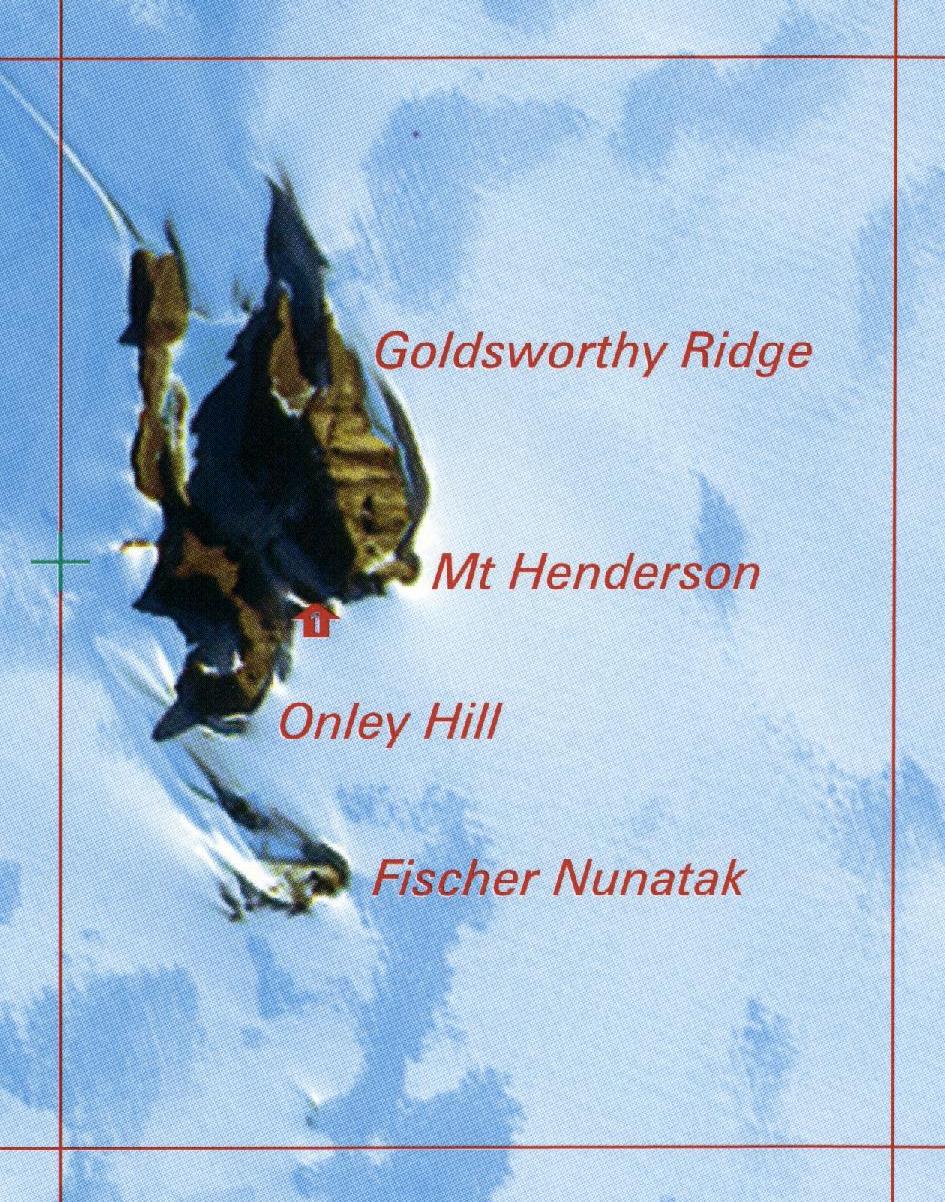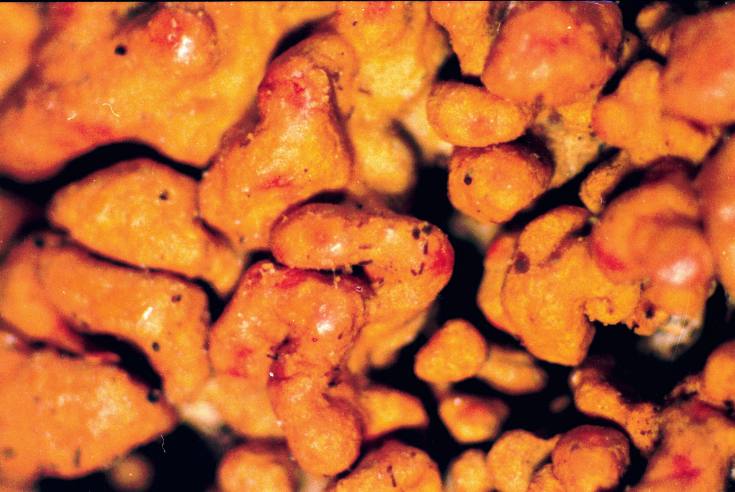|
Mount Henderson (Holme Bay)
Mount Henderson () is a mountain in the Framnes Mountains of Mac. Robertson Land in the Antarctic. It is southeast of Holme Bay and northeast of the Masson Range. Physical Mount Henderson is a massive mountain rising through the ice sheet southeast of Holme Bay and a like distance northeast of the north end of the Masson Range. The mountain is about south-southeast of Mawson Station. The rocky massif covers about . Its ridges rise to about above sea level. There are large areas of moraine and moraine scree slopes, and large melt lakes between the ridges. Glacial erratic boulders of light-colored granitic gneiss cover the lower slopes of the mountain, but are not found more than about above the present-day ice surface. Above this level the darker charnockite bedrock is exposed. Probably the boulders were transported and deposited by ice during the last glacial maximum, while the exposed bedrock would have remained above the ice. Botany Thirteen species of lichen and one of m ... [...More Info...] [...Related Items...] OR: [Wikipedia] [Google] [Baidu] |
Antarctica
Antarctica () is Earth's southernmost and least-populated continent. Situated almost entirely south of the Antarctic Circle and surrounded by the Southern Ocean, it contains the geographic South Pole. Antarctica is the fifth-largest continent, being about 40% larger than Europe, and has an area of . Most of Antarctica is covered by the Antarctic ice sheet, with an average thickness of . Antarctica is, on average, the coldest, driest, and windiest of the continents, and it has the highest average elevation. It is mainly a polar desert, with annual precipitation of over along the coast and far less inland. About 70% of the world's freshwater reserves are frozen in Antarctica, which, if melted, would raise global sea levels by almost . Antarctica holds the record for the lowest measured temperature on Earth, . The coastal regions can reach temperatures over in summer. Native species of animals include mites, nematodes, penguins, seals and tardigrades. Where vegetation o ... [...More Info...] [...Related Items...] OR: [Wikipedia] [Google] [Baidu] |
Caloplaca Elegans
''Rusavskia elegans'' (formerly ''Xanthoria elegans''), commonly known as the elegant sunburst lichen, is a lichenized species of fungus in the genus '' Rusavskia'', family Teloschistaceae. Recognized by its bright orange or red pigmentation, this species grows on rocks, often near bird or rodent perches. It has a circumpolar and alpine distribution. It was one of the first lichens to be used for the rock-face dating method known as lichenometry. Taxonomy ''Rusavskia elegans'' was first formally described by Johann Heinrich Friedrich Link as ''Lichen elegans'' in 1791, and transferred to the genus ''Xanthoria'' by Theodor Magnus Fries (son of Elias Magnus Fries) in 1860. In 2003, Sergey Kondratyuk and Ingvar Kärnefelt transferred the taxon to their newly circumscribed genus '' Rusavskia'', in which it is the type species. Although the new genus was not initially widely accepted, subsequent molecular phylogenetic studies showed the validity of the new classification. Desc ... [...More Info...] [...Related Items...] OR: [Wikipedia] [Google] [Baidu] |
Antarctic Names Committee Of Australia
The Australian Antarctic Names and Medals Committee (AANMC) was established to advise the Government on names for features in the Australian Antarctic Territory and the subantarctic territory of Heard Island and the McDonald Islands. The committee also issues nominations Governor General for the award of the Australian Antarctic Medal. Committee members were appointed by the Minister or Parliamentary Secretary responsible for Antarctic matters. The committee was founded in 1952 as the Antarctic Names Committee of Australia, and changed to the current name in 1982 to reflect the multiple functions that the committee is responsible for. The committee was replaced by the Australian Antarctic Division Place names Committee in 2015. Features named by the committee * Fyfe Hills, named after W.V. Fyfe, Surveyor General of Western Australia * Goldsworthy Ridge, named after R.W. Goldsworthy, survey field assistant * Gowlett Peaks, named after Alan Gowlett, engineer * Haigh Nunatak, ... [...More Info...] [...Related Items...] OR: [Wikipedia] [Google] [Baidu] |
ANARE
The Australian National Antarctic Research Expeditions (ANARE ) is the historical name for the Australia: Antarctic Program#Australian Antarctic program, Australian Antarctic Program (AAp) administered for Australia by the Australian Antarctic Division (AAD). History Australia has had a long involvement in South Pole, south polar regions since as early as Douglas Mawson's Australasian Antarctic Expedition in 1911. Further Australian exploration of the Antarctic continent was conducted during the British Australian and New Zealand Antarctic Research Expedition (BANZARE), which was conducted over the years 1929–1931. The Australian National Antarctic Research Expeditions were established in 1947 with expeditions to Macquarie Island and Heard Island. In 1948 the Australian Antarctic Division (AAD) was established to administer the expedition program. ANARE Name The name ANARE fell out of official use in the early 2000s. However current and former Australian Antarctic expedit ... [...More Info...] [...Related Items...] OR: [Wikipedia] [Google] [Baidu] |
Fischer Nunatak
Fischer Nunatak () is a nunatak, high, standing south of Mount Henderson in the northeast part of the Framnes Mountains, Mac. Robertson Land, Antarctica. Discovery Fischer Nunatak was mapped by Norwegian cartographers from air photos taken by the Lars Christensen Expedition, 1936–37, and named "Sornuten" (the south peak). It was renamed by the Australian National Antarctic Research Expeditions (ANARE) for H.J.L. Fischer, cook at Mawson Station in 1958. In 1954 a barge caravan was used as a remote weather station on the nunatak. It was removed in 1989. Appearance Fischer Nunatak is about south of Mount Henderson, and has similar geology to Mount Henderson. It is about high, with an area of exposed rock that covers about . There is a broad valley to the south of the nunatak. As of 1998 the ice surrounding the nunutak had many crevasses. The nunatak has a long, smooth slope that is ideal for downhill skiing during the rare periods when there is enough snow cover. Plan ... [...More Info...] [...Related Items...] OR: [Wikipedia] [Google] [Baidu] |
Australian Department Of External Affairs
The Department of Foreign Affairs and Trade (DFAT) is the department of the Australian federal government responsible for foreign policy and relations, international aid (using the branding Australian Aid), consular services and trade and investment (including trade and investment promotion Austrade). In 2021, DFAT allocated USD 3.4 billion of official development assistance, equivalent to 0.22% of gross national income. The head of the department is its secretary, presently Jan Adams. She reports to the Penny Wong, the Minister for Foreign Affairs. History The department finds its origins in two of the seven original Commonwealth Departments established following Federation in 1901: the Department of Trade and Customs and the Department of External Affairs (DEA), headed by Harry Wollaston and Atlee Hunt respectively. The first DEA was abolished on 14 November 1916 and its responsibilities were undertaken by the Prime Minister's Department and the Department of Home and Te ... [...More Info...] [...Related Items...] OR: [Wikipedia] [Google] [Baidu] |
Douglas Mawson
Sir Douglas Mawson OBE FRS FAA (5 May 1882 – 14 October 1958) was an Australian geologist, Antarctic explorer, and academic. Along with Roald Amundsen, Robert Falcon Scott, and Sir Ernest Shackleton, he was a key expedition leader during the Heroic Age of Antarctic Exploration. Mawson was born in England and came to Australia as an infant. He completed degrees in mining engineering and geology at the University of Sydney. In 1905 he was made a lecturer in petrology and mineralogy at the University of Adelaide. Mawson's first experience in the Antarctic came as a member of Shackleton's ''Nimrod'' Expedition (1907–1909), alongside his mentor Edgeworth David. They were part of the expedition's northern party, which became the first to attain the South Magnetic Pole and to climb Mount Erebus. After his participation in Shackleton's expedition, Mawson became the principal instigator of the Australasian Antarctic Expedition (1911–1914). The expedition explored thousand ... [...More Info...] [...Related Items...] OR: [Wikipedia] [Google] [Baidu] |
British Australian And New Zealand Antarctic Research Expedition
The British Australian (and) New Zealand Antarctic Research Expedition (BANZARE) was a research expedition into Antarctica between 1929 and 1931, involving two voyages over consecutive Austral summers. It was a British Commonwealth initiative, driven more by geopolitics than science, and funded by the United Kingdom, Australia and New Zealand. The leader of the BANZARE was Sir Douglas Mawson and there were several subcommanders (Captain K.N. MacKenzie, who replaced Captain John King Davis for the second summer) on board the RRS Discovery, the ship previously used by Robert Falcon Scott. The BANZARE, which also made several short flights in a small plane, mapped the coastline of Antarctica and discovered Mac. Robertson Land and Princess Elizabeth Land (which later was claimed as part of the Australian Antarctic Territory). The voyages primarily comprised an "acquisitive exploratory expedition", with Mawson making proclamations of British sovereignty over Antarctic lands at each o ... [...More Info...] [...Related Items...] OR: [Wikipedia] [Google] [Baidu] |
RRS Discovery
The RRS ''Discovery'' is a barque-rigged auxiliary steamship built in Dundee, Scotland for Antarctic research. Launched in 1901, she was the last traditional wooden three-masted ship to be built in the United Kingdom. Her first mission was the British National Antarctic Expedition, carrying Robert Falcon Scott and Ernest Shackleton on their first, and highly successful, journey to the Antarctic, known as the ''Discovery'' Expedition. After service as a merchant ship before and during the First World War, ''Discovery'' was taken into the service of the British government in 1923 to carry out scientific research in the Southern Ocean, becoming the first Royal Research Ship. The ship undertook a two-year expedition – the Discovery Investigations – recording valuable information on the oceans, marine life and being the first scientific investigation into whale populations. From 1929 to 1931 ''Discovery'' served as the base for the British Australian and New Zealand Antarctic ... [...More Info...] [...Related Items...] OR: [Wikipedia] [Google] [Baidu] |
Gasparrinia Harrisoni
''Calogaya'' is a genus of lichen-forming fungi belonging to the family Teloschistaceae. It has 19 species. The genus was circumscribed in 2013 by Ulf Arup, Ulrik Søchting, and Patrik Frödén. The generic name ''Calogaya'' ("spectacular Gaya") honours Dr. Ester Gaya ( fl. 2001), a Spanish botanist from the University of Barcelona The University of Barcelona ( ca, Universitat de Barcelona, UB; ; es, link=no, Universidad de Barcelona) is a public university located in the city of Barcelona, Catalonia, in Spain. With 63,000 students, it is one of the biggest universities i .... Species *'' Calogaya alaskensis'' *'' Calogaya altynenis'' – China *'' Calogaya arnoldii'' *'' Calogaya arnoldiiconfusa'' *'' Calogaya biatorina'' *'' Calogaya bryochrysion'' *'' Calogaya decipiens'' *'' Calogaya ferrugineoides'' *'' Calogaya haloxyli'' – China *'' Calogaya mogoltanica'' *'' Calogaya orientalis'' – China *'' Calogaya pusilla'' *'' Calogaya qinghaiensis'' *'' Calog ... [...More Info...] [...Related Items...] OR: [Wikipedia] [Google] [Baidu] |
Biatorella Antarctica
''Biatorella'' is a genus of fungi A fungus ( : fungi or funguses) is any member of the group of eukaryotic organisms that includes microorganisms such as yeasts and molds, as well as the more familiar mushrooms. These organisms are classified as a kingdom, separately from ... belonging to the family Biatorellaceae. The genus has a cosmopolitan distribution. Species The genus ''Biatorella'' includes the following species: * '' Biatorella algerica'' * '' Biatorella algoviae'' * '' Biatorella amabilis'' * '' Biatorella antarctica'' * '' Biatorella australica'' * '' Biatorella austroafrica'' * '' Biatorella camptocarpa'' * '' Biatorella consanguinea'' * '' Biatorella conspurcans'' * '' Biatorella contigua'' * '' Biatorella cyphalea'' * '' Biatorella floridensis'' * '' Biatorella fossarum'' * '' Biatorella germanica'' * '' Biatorella hemisphaerica'' * '' Biatorella praenotata'' * '' Biatorella rappii'' * '' Biatorella rousselii'' * '' Biatorella saxicola'' * '' Bia ... [...More Info...] [...Related Items...] OR: [Wikipedia] [Google] [Baidu] |



.jpg)


